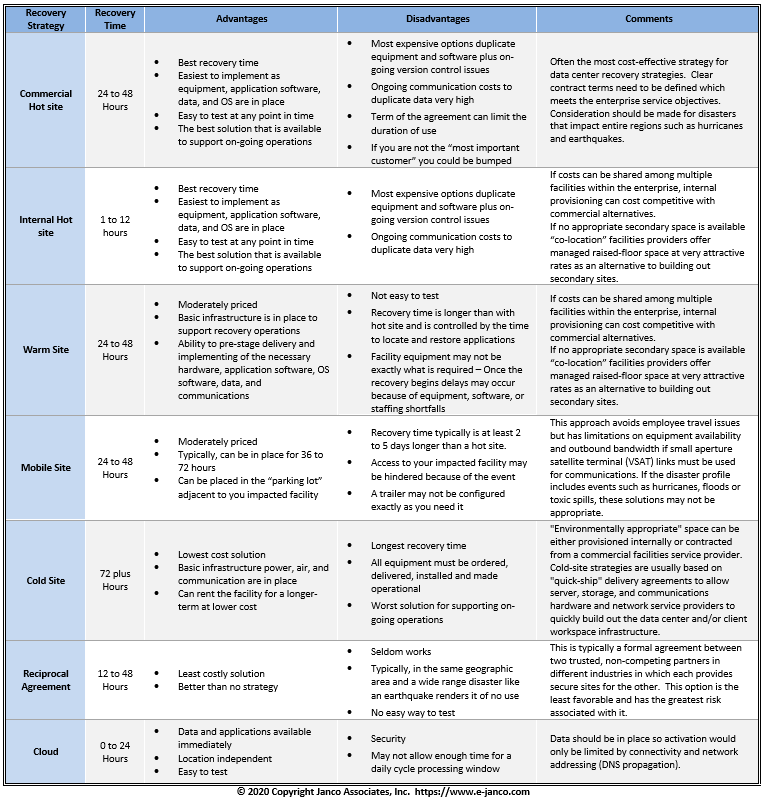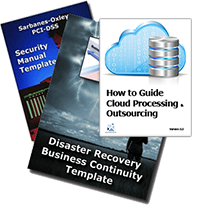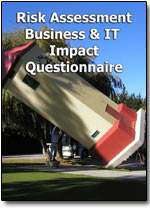Data Center Recovery Strategy
A critical component of a disaster recovery business continuity is the data center recovery strategy -- Hot Site, Warm Site, Mobile Facilities, Cold Site, Reciprocal Agreement, or Cloud -- Which to choose and why
Which is the best strategy for data center recovery of hot, warm, mobile, and cold sites versus reciprocal agreements?
Hot site
A hot site is a full or partial duplicate for a primary IT operation, including complete computer systems and near-real-time backups for systems, applications and data. In its most expensive form, mirroring software is used to keep a hot backup site and a primary site synchronized. They typically are duplicates of existing data centers.
Hot-site pricing is usually based on the amount of processing power and data storage needed, networking needed to support operations, voice and data communications for company employees, desk space for employees relocated to the hot site, conference room space, and other conveniences needed to support potentially extended stays at the site. Hot sites are largely in move-in condition so that employees can be productive within hours of declaring a disaster. Monthly hot-site fees are based on technology requirements, the number of seats required, square footage used. Ongoing monthly fees can range from under $1,000 to over $50,000 per month based on the size and complexity of the data center's configuration. Disaster declaration fees may also be assessed prior to employees appearing on-site.
Data Center Recovery Strategy

Table extracted from Janco's Disaster Recovery / Business Continuity Template. See DR/BC
Warm sites
A warm site is a hot site minus data replication. That is, a warm site offers access to space, utilities and equipment, but requires current backups be installed, and systems and services brought online to become operational. A warm site may be a complete duplicate of an original site, but will typically provide only a subset of mission-critical equipment, services and data.
A warm site works for businesses or organizations that can tolerate one or two days of downtime, which represents the typical delay between when a primary site goes down and a recovery site comes up. Many major and medium-sized businesses opt for warm sites because costs are significantly lower than for hot sites. Although equipment and siting costs are similar, data synchronization and ongoing maintenance and monitoring costs don't apply to warm sites.
Mobile sites
An offshoot of a warm site is a mobile site that consists of trailers that are pre-configured to meet requirements and are flown in, moved by truck are set up in predetermined locations around the country where they can be activated during an emergency
Cold Site
Cold sites which are empty facilities, such as trailers, warehouses, open space in existing data centers specially equipped for emergency use; or simply empty buildings that are wired for power, communications and HVAC but are empty. The cost model for each is quite different.
By contrast, the cost to obtain a cold site will be much less. The delivery of systems and technology may take longer, depending on what is needed, the location of the supplier(s), and any other situations, such as a large-scale regional disaster that affects many organizations.
Cold sites require advance planning to locate primary and alternate suppliers of computing systems, data storage and networking equipment, data center infrastructure equipment (e.g., equipment racks and emergency power supplies), office equipment (e.g., desks, chairs, lighting and copiers), and supplies (e.g., paper, forms and pencils) to support a predetermined number of employees. In addition, arrangements to have these assets delivered and installed at the cold site are needed, preferably in advance.
Investments in cold sites may be as little as nothing (assuming the investment will be made at the time of disaster) or nominal (e.g., a monthly fee to "hold" the site for your organization). The cost to outfit a cold site and make it usable can be expensive and will take time, often several days or a week or more. For example, some furniture companies specializes in outfitting offices with temporary furniture, claims to be able to outfit an office area within 48 hours of order placement.
Cloud
The cloud does work well for some mission critical application. This includes web hosting and corporate e-mail. Other applications can be run via the web but there would be serious security concerns for sensitive information.
Order DRP BCP Template DRP BCP Sample





